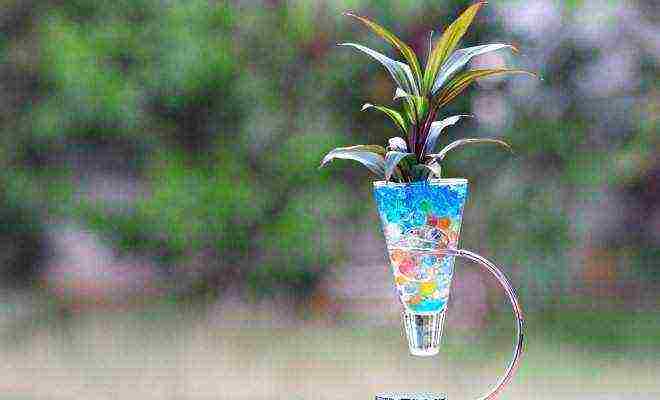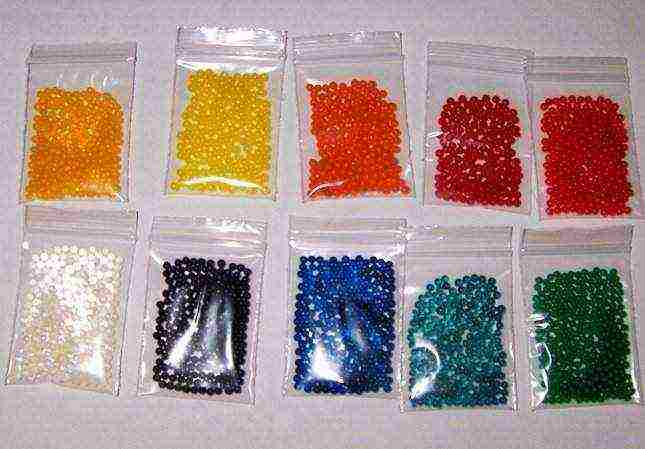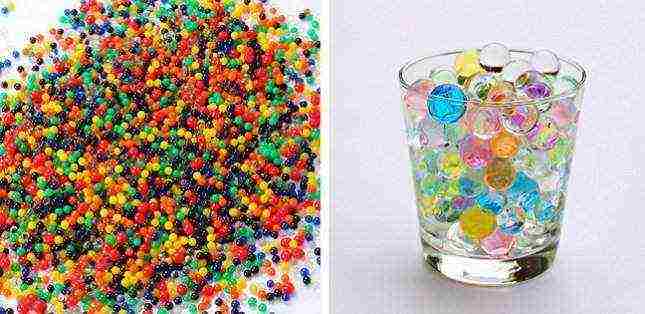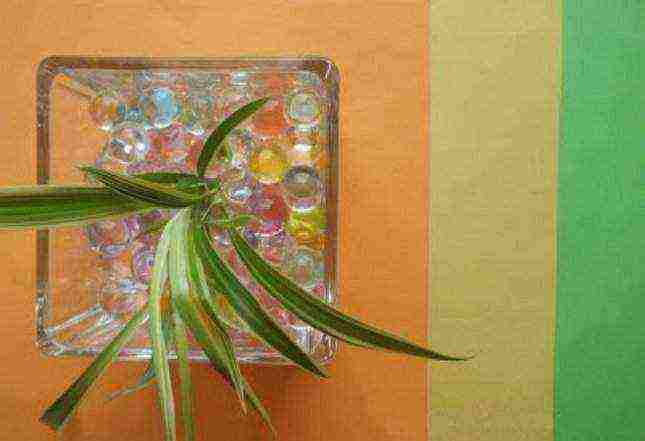Content

The hydrogel is capable of absorbing and retaining moisture for a long time, which makes it very useful in the flower industry. How can the substance be used?
Hydrogel is a polymer compound that is actively used in agriculture, and recently flower growers and phytodesigners have also paid attention to it. Plants can be planted directly in the hydrogel, or you can mix the substance with soil for indoor flowers. The liquid that the hydrogel absorbs does not evaporate or flow onto the tray, and also does not lose nutrients.
Planting plants in a hydrogel
A plant in a hydrogel can become not just an interior decoration, but also an excellent gift, because it looks very original. The hydrogel is commercially available in various colors, so it can be used to create a very bright and beautiful composition. The cost of the substance is not very high, and its consumption is quite small, so one sachet will be enough for a long time.

Hydrogel granules
Tableware. Containers for planting plants should be chosen transparent so that the balls or pieces of hydrogel are clearly visible. As for the shape of the vessels, it can be absolutely any (when planting plants in a hydrogel, the possibility of damaging the roots is minimized). For small plants growing in rosettes, glass goblets can be chosen, and for larger specimens, round or cylindrical vases are suitable.

Glass containers with hydrogel
Hydrogel preparation... You need to fill in the hydrogel with clean water suitable for irrigation (settled, distilled). For 1 g of dry matter, about 300 ml of liquid can go away. It is best to look at the required proportions on the packaging.

Hydrogel
What plants can be grown in a hydrogel? Grow well in polymer absorbent shefflera, chlorophytum, dracaena, tradescantia, syngonium, cordilina, scindapsus... Suitable for shaded corners of the apartment spathiphyllums, ficuses and sansevieria... Some growers grow flowering plants in hydrogel: Kalanchoe, Guzmania, Tilandsia and anthurium.
Do not plant flowers in the hydrogel that do not need frequent watering. For example, most succulents and epiphytes store moisture in leaves and roots, and being in a humid environment will cause them to rot.
Landing. Planting flowers in a hydrogel does not fundamentally differ from planting in ordinary soil. First, the roots of the plants must be rinsed well under running water so that no parts of the old soil remain on them. Next, the container for planting must be filled with a hydrogel, the plant should be placed in it and a little more substance added. That's all, nothing complicated. The only thing to watch out for is to keep the plant upright (this can be a problem as the hydrogel is very slippery).

Plant in hydrogel
Features of care. Watering a plant planted in a hydrogel should be 6 times less frequent than plants in soil. The substance itself will tell you about the need for watering, which will begin to settle a little - this means that a lot of moisture has begun to leave it.
Planting plants in soil with hydrogel
Planting indoor flowers in such soil makes it much easier to care for them, because such plants can be watered less often. In addition, the hydrogel helps plants adapt to new conditions more quickly after transplanting.
How to properly formulate a hydrogel substrate?
1. The first step is to mix the substance with a suitable substrate. For 1 liter of soil, only 2-3 g of hydrogel is required.
2.Then the granules should be mixed well with the ground.
3. Now the resulting mixture must be watered abundantly so that it is well saturated, and the hydrogel has absorbed the required amount of moisture. Now plants can be planted in such land.
The hydrogel in the substrate retains its qualities for 3-5 years, so it is enough to add it to the ground once during planting.
What plants can be grown in a hydrogel? For growing in a hydrogel substrate, moisture-loving plants are suitable, as well as species that are suitable for growing in hydroponics. So, you can plant in soil with polymer chlorophytum, ivy, codiaum, kalanchoe... Some growers even grow succulents like this, for example, fat woman or spurge... And beautifully flowering Saintpaulias, petunias, gloxinias, when planted in a substrate with a hydrogel, even begin to grow more intensively and bloom more abundantly.
Features of care. Caring for plants planted in the ground with the addition of hydrogel granules is practically no different from ordinary care. The only thing to remember is not to water the plants too often.
 Grow flowers in a hydrogel now it has become very fashionable. True, plants look beautiful in glass containers filled with colored hydrogel.
Grow flowers in a hydrogel now it has become very fashionable. True, plants look beautiful in glass containers filled with colored hydrogel.
The hydrogel itself is a polymeric compound (acrylamide), non-toxic and absolutely not harmful to the plant. The hydrogel is capable of absorbing and retaining water and giving it back to the roots in case of its lack and to absorb water in case of its excess. Thus, saving the plant from drying out and then waterlogging.
In appearance, the hydrogel resembles granulated sugar. When wet, the granules absorb water and increase in size 300 times. Before use, the hydrogel is poured with clean, settled water or distilled or filtered, at the rate of 1 gram of dry matter per 200-300 ml of water. Complete swelling lasts about 2 hours.
Planting a plant in a gel does not differ from planting in a ground, except that the problem of fixing the plant in an upright position can melt. Before planting, the roots must be well rinsed with the soil and carefully spread the roots over the surface of the hydrogel and covered with gel to the desired level. Over time, the roots grow into granules, and the plant receives water without interruption. In such cases, watering should be done less often by about 5 times, and reduced in volume. And you also need to feed less often.
Typically, a hydrogel lasts about 5 years, by the end of the term, granules begin to disintegrate, less water is absorbed and the mass becomes shapeless.
The plant can be planted either in a pure hydrogel or mixed into the soil. In addition, it improves the structure of the soil, more crumbly from clay and more lumpy from sandy. You can mix with the soil approximately 1: 1. It is very good to use hydrogel in containers and hanging baskets. You can even dilute it with a complex fertilizer and then there is no need for feeding for some time.
Growing flowers in a hydrogel is convenient, the plant suffers less from waterlogging and then drying out of the soil. It is also easy to use, prepare, and durable.
Plants that adapt well to the hydrogel: dracaena, shefflera, cordilina, chlorophytum, tradescantia, cyperus, syngonium, scindapsus, ivy, spathiphyllum, arrowroot, aglaonema, sansevieria, ficus, anthurium, guzmandia, kalanchoe, balsamy ...
Plants requiring rare watering (succulents and some epiphytes) with dense leathery leaves or tubers and bulbs that store water are not suitable for growing in a hydrogel.
Flowers and plants grow beautifully in a hydrogel. Having studied the opinions and reviews, I came to the conclusion that water and fertilizing are the main requirement, and sometimes the soil is not needed at all ...
One of the innovations in the field of growing indoor flowers and using them as decorative accents in the interior is crystalline soil (hydrogel).It allows you to grow plants without using soil in glass vases and transparent vessels.
A vessel with a plant and crystalline soil looks absolutely stunning - especially if you use a backlight or put it on a window. What kind of miracle is this, crystalline soil? Let's figure it out together!
How does a hydrogel work
It is a polymer that absorbs moisture in a volume 80-150 times its original size. It retains moisture for a long time, giving it to the roots of the plant.
Together with moisture, it gives off nutrients that contribute to the long-term preservation of the plant. In a granule of crystalline soil there are microscopic holes that trap air and water.
Use and care
What is it for: Crystalline soil or hydrogel is a moisture-absorbing polymer (polyacrylamide) that is able to absorb 80-150 times its original size of water and retain moisture for a long time.
Method of use - just pour into a vessel and fill with water for 6-8 hours. In warm water, the hydrogel will swell faster. Caring for the hydrogel is simple - it only requires adding water from time to time as it evaporates.
How to plant plants
To plant plants in crystalline soil, you need to carefully and thoroughly clean the roots from the earth. Many plant species can exist in a hydrogel - they are listed below.
Those plants that grow in hydroponics are able to survive in crystalline soil. It is not recommended to plant cacti, succulents and orchids, and other flowers that are afraid of a large amount of moisture.
Which plants are suitable
Indoor plants suitable for growing on crystalline soil: Dieffenbachia, Dracaena, Caladium, arrowroot, Philodendron, Fittonia, Chlorophytum. You can try any plant that takes root in water.
Video instructions
It is considered by the example of planting violets in a hydrogel.


